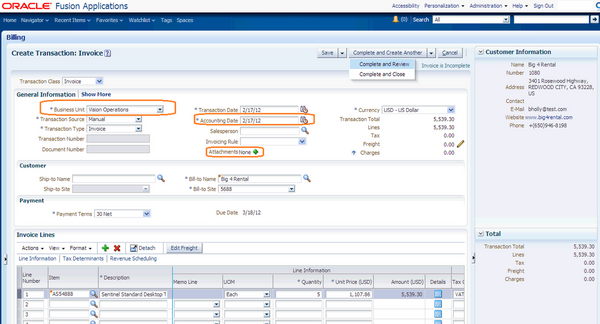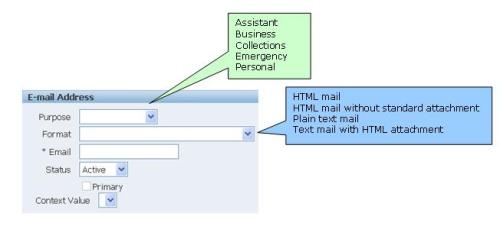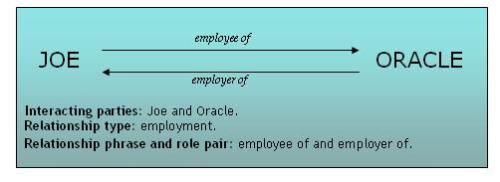HZ_PARTIES:The HZ_PARTIES table stores basic information about parties that can be shared with any relationship that the party might establish with another party. The primary key for this table is PARTY_ID.Few Important Columns are
- PARTY_ID: Party identifier
- PARTY_NUMBER: Unique identification number for this party
- PARTY_NAME: Name of the party
- PARTY_TYPE: The party type can only be Person, Organization, Group or Relationship.
HZ_PARTY_SITES:
The HZ_PARTY_SITES table links a party (HZ_PARTIES) and a location (HZ_LOCATIONS) and stores location-specific party information. One party can optionally have one or more party sites. One location can optionally be used by one or more parties. The primary key for this table is PARTY_SITE_ID.
Few Important Columns are
- PARTY_SITE_ID: Party site identifier.
- PARTY_ID: Identifier for the party. Foreign key to the HZ_PARTIES table.
- LOCATION_ID: Identifier for the party site. Foreign key to the HZ_LOCATIONS table.
- PARTY_SITE_NUMBER: Party site number.
- PARTY_SITE_NAME: User-defined name for the site.
- ADDRESSEE: Addressee information.
HZ_LOCATIONS:
The HZ_LOCATIONS table stores information about a delivery or postal address such as building number, street address, postal code, and directions to a location. This table provides physical location information about parties (organizations and people) and customer accounts. The primary key for this table is LOCATION_ID.
Few Important Columns are
- LOCATION_ID: Unique identifier for this location
- COUNTRY: Country code from the TERRITORY_CODE column in the FND_TERRITORY table
- ADDRESS1: First line for address
- ADDRESS2: Second line for address
- ADDRESS3: Third line for address
- ADDRESS4: Fourth line for address
- CITY: City
- POSTAL_CODE: Postal Code
- STATE: State
- ADDRESS_KEY: Derived key that facilitates fuzzy searches
HZ_CUST_ACCOUNTS:
The HZ_CUST_ACCOUNTS table stores information about customer accounts , or business relationships that the deploying company establishes with a party of type Organization or Person. This table focuses on business relationships and how transactions are conducted in the relationship. Since a party can have multiple customer accounts, this table might contain several records for a single party. For example, an individual person can establish a personal account, family account, and a professional account for a consulting practice. The primary key for this table is CUST_ACCOUNT_ID.
Few Important Columns are
- CUST_ACCOUNT_ID: Customer account identifier
- PARTY_ID: A foreign key to the HZ_PARTY table.
- ACCOUNT_NUMBER: Account Number
- CUSTOMER_TYPE: Receivables lookup code for the CUSTOMER_TYPE attribute. I for internal customers, R for revenue generating external customers.
- CUSTOMER_CLASS_CODE: Customer class identifier
HZ_CUST_ACCT_SITES_ALL:
The HZ_CUST_ACCT_SITES_ALL table stores all customer account sites across all operating units. Customer account sites are addresses, for customer accounts, where the deploying company does business with its customers. One customer account can have multiple customer account sites, and customer account sites for one customer account can belong to multiple operating units. The primary key for this table is CUST_ACCT_SITE_ID.
Few Important Columns are
- CUST_ACCT_SITE_ID: Customer site identifier
- CUST_ACCOUNT_ID: Identifier for a customer account. Foreign key to the HZ_CUST_ACCOUNTS table
- PARTY_SITE_ID: Identifier for a party site. Foreign key to the HZ_PARTY_SITES table
- BILL_TO_FLAG: Indicates if this is a Bill-To site.
- SHIP_TO_FLAG: Indicates if this is a Ship-To site.
- MARKET_FLAG: Indicates if this is a Marketing site.
HZ_CUST_SITE_USES_ALL:
The HZ_CUST_SITE_USES_ALL table stores business purposes assigned to customer account sites, for example Bill-To, Ship-To, and Statements. Each customer account site can have one or more purposes. This table is a child of the HZ_CUST_ACCT_SITES_ALL table, with the foreign
key CUST_ACCT_SITE_ID. The HZ_CUST_SITE_USES_ALL table also stores operating unit identifier, though the HZ_CUST_ACCT_SITES_ALL table itself stores the operating unit for customer account sites. The primary key for this table is SITE_USE_ID.
Few Important Columns are
- SITE_USE_ID: Site use identifier
- CUST_ACCT_SITE_ID: Identifier for the customer account site. Foreign key to the HZ_CUST_ACCT_SITES_ALL table
- SITE_USE_CODE: Business purpose assigned to customer site account, such as Bill-To, Market, and Statements.
- PRIMARY_FLAG: Indicates if this site is the primary site for this customer account. Y for the primary customer account site. N for other customer account sites.
HZ_CUSTOMER_PROFILES:
The HZ_CUSTOMER_PROFILES table stores information about the credit characteristics of a single customer account or a customer account site or a party. A profile class defined in the
HZ_CUSTOMER_PROFILE_CLASSES table can be used to provide default values for the attributes in this table. The primary key for this table is CUST_ACCOUNT_PROFILE_ID.
Few Important Columns are
- CUST_ACCOUNT_PROFILE_ID: Unique identifier of this customer profile
- CUST_ACCOUNT_ID: Identifier for the Customer Account. Foreign key to the HZ_CUST_ACCOUNTS table.
- STATUS: Indicates whether the profile is active or inactive
HZ_CUST_PROFILE_CLASSES:
The HZ_CUST_PROFILE_CLASSES table stores information about the credit characteristics that are common across a group of customer accounts. The characteristics specified in this table can be used as default characteristics for similar customer accounts. The primary key for this table is PROFILE_CLASS_ID.
HZ_PARTY_RELATIONSHIPS:
The HZ_PARTY_RELATIONSHIPS table stores information about relationships between parties.
Relationship between the tables











Recent Comments